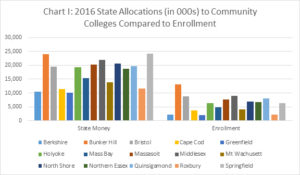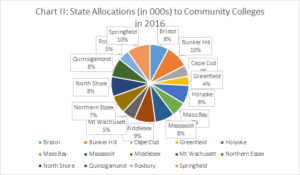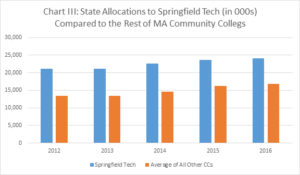How Does MA Allocate Money to Its Community Colleges?
State funding for community colleges is widely considered to be allocated on the basis of enrollment. The bigger a school’s student body, the more money it receives. However, Massachusetts does not appear to follow this pattern for every campus.
As demonstrated in Chart I, the bigger schools – Bunker Hill and Middlesex, for example – are on the upper end of state money appropriations for 2016. Conversely, the smallest – Greenfield, Berkshire, Roxbury – receive less.
The schools that defy this size-money correlation are Bristol, North Shore, Massasoit, and Springfield Tech.
At 6,286 students, Springfield Tech has fairly modest enrollment relative to its peers (As a frame of reference, Bunker Hill and Middlesex have 13,142 and 9,021 students, respectively). Yet in 2016, Springfield Tech received $24 million from the commonwealth, solidifying its rank as the community college that receives the most state support.
Bristol is another college that appears to buck the trend of enrollment-based funding. With 8,761 students, it’s the third largest school. Yet in 2016, Bristol was only the seventh biggest recipient of state money – $19.5 million – behind smaller schools like North Shore and Massasoit.
These anomalies beg the question: If funding allocations aren’t based on school size, how does the commonwealth determine which community colleges get what? The answer may be attributed to Massachusetts’s newly implemented “performance funding” initiative.
Formally introduced in 2015, the performance-based funding model links a school’s state dollars to its student success rates. The formula was implemented as a remedy to three growing educational problems: The inequalities in per student funding that have developed from schools’ diverging growth rates, lack of a mechanism for allocating funds in relation to aspects of institutional performance that reflect statewide higher education goals, and the commonwealth’s emphasis on the role of community colleges in preparing students for jobs in the state’s economy.
The New England Board of Higher Education reports that under this new system, half of each college’s allocation is tied to three performance variables: Enrollment, degree completion, and alignment (the degree to which a school successfully prepares its students in economy-fueling disciplines).The formula (which operates as a supplement to each school’s annual “base” appropriation) is designed to incentivize colleges to advance student success. Thus, the size of your student body does not necessarily guarantee you the most funding.
While these discrepancies are small, they are noticeable.
Bristol’s comparatively meager funding could be attributed to student performance stats that are low relative to its peers. While Bristol had a 21% graduation rate and a 52% overall retention rate, only 13% of its students transferred to a four-year college. North Shore, meanwhile, has a 19% graduation rate, a 19% transfer-out rate, and a 53% overall retention rate. Massasoit’s graduation rate (16%) is a bit lower than Bristol’s, but its transfer-out rate is significantly higher (22%) and it has a comparatively high 55% overall retention rate.
Springfield Tech remains an anomaly. As demonstrated in Chart III, the college has enjoyed a pattern of consistently high state funding.
This influx of state money is puzzling considering Springfield Tech’s performance data. In 2016, the college’s graduation rate was a comparatively high 22%. Its transfer-out rate, however, was 13% — the same as Bristol’s. Its overall retention rate was 52%, no higher than North Shore’s or Massasoit’s.
Indeed, Springfield Tech’s stats appear to have actually worsened slightly over the last five years. In 2014, its graduation, transfer-out, and overall retention rates were 21%, 15%, and 51%, respectively. In 2012, they were 20%, 17%, and 53%.
Over the last few years, the commonwealth has been particularly focused on investing in Springfield Tech. In 2015, Governor Charlie Baker announced that an extra $3 million would go towards capital projects for the campus. The school has unveiled development plans that include a brand new building initiative and expanded parking capacity.
Springfield Tech has also been enjoying supplemental federal funding and grants. In 2016, it was awarded a five-year, $3.4 million grant from the U.S. Department of Education to help advance Hispanic and low-income students in science, technology, engineering and math concentrations.
While MA’s performance-based funding allotment is admirable in theory, it appears that not all community colleges are held to the same standard.







